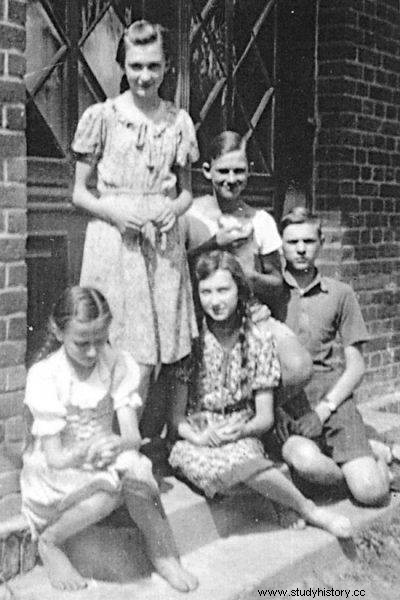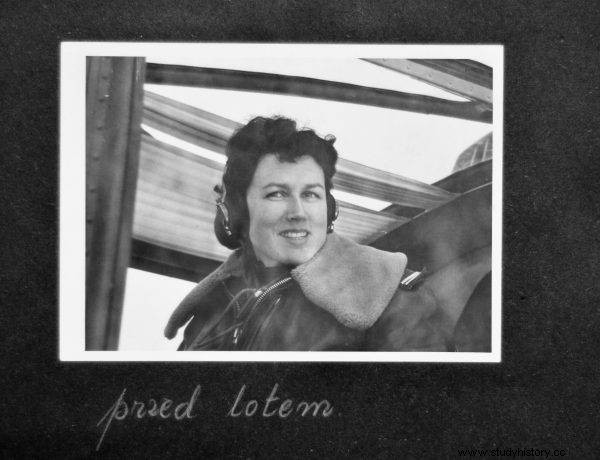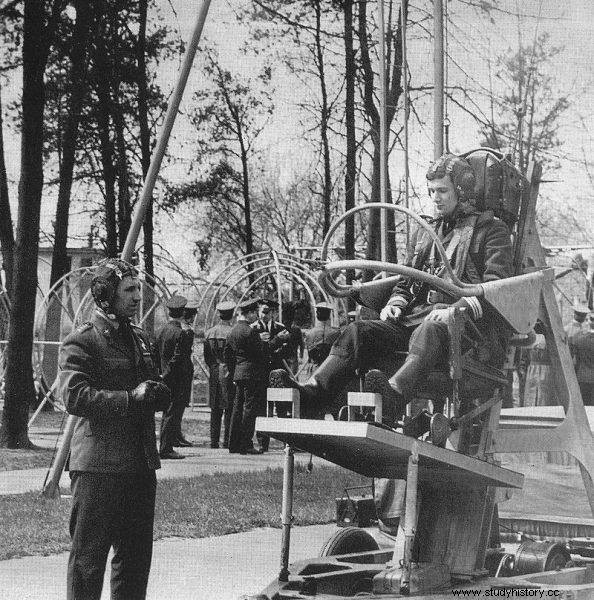Not only little boys dream of flying. Women also conquered heaven, though it was always harder for them. Especially when - like Colonel pil. Zofia Dziewiszek-Andrychowska - had to overcome the trauma of World War II and then break through the glass ceiling in an environment dominated by men.
It was the scariest night of my life. The Gestapo stormed our forester's lodge in Wykno on September 3-4, 1944. A truck and two cars filled with Germans pulled up in front of the house. They burst into the house and the first thing they did was shoot the dog (...).
"Where they've gone, you better not go"
They put me, my mother and my older sister in a passenger car in the back seat and they took us away without a word. After some time it turned out that we were going towards Tomaszów Mazowiecki, to the prison. (...) We lived in prison in the same way as other arrested people. Every morning they let us out to the yard, separate men and women, to the courtyard in front of the prison. Fifteen minutes of fresh air a day. There was always a Ukrainian commander of the prison.
One day he said to my mother:"This little girl will go digging trenches from tomorrow, she will be more in the air and she will get better soup there." Mom replied that she would be able to walk as soon as she had to. Indeed, the next morning they took me from my cell (…).

Zofia Dziewiszek-Andrychowska experienced the horrors of World War II as a child
My digging work lasted maybe a week, when one day I returned to prison with the soup, and before I joined my family, they took me to the commandant's office. I stood in front of him and he said, "Yours are not here anymore." Surprised, I asked:"How is it not?" And he said briefly: Well, it doesn't. There is hardly anyone in the building anymore. (…) Where they went, you'd better not go. ”
(...) To this day, I do not know why I was not taken to the camp. Maybe I was lucky that I was digging these ditches and I was not at the deportation from prison?
Strength from a dream
It was only a few weeks after the end of the war that I got a message from my mother and sisters. The letter was from Sweden. My mother wrote that at the end of the war, the Swedish Red Cross bought some of the prisoners from the camp and deported them from Germany. They took care of them and they could all stay in Sweden, but my mother wrote that she would return to Poland as soon as possible, to me. Indeed, in December 1945, my mother and sisters were back in Poland.
(...) we started a new post-war life, but the war stayed with me forever. ...
I pondered where I could feel strong, where, if war broke out again, I would be able to fight and win. (...) If you fight, it is in the army, preferably in the plane. That's what I thought I would be strong on the plane. The plane will give me strength and a chance to win. I decided that I would do everything to get into the military aviation (...).

The text is an excerpt from the book by Anna Rudnicka-Litwinek "Girls on the Wing", which has just been released by the Znak Horyzont publishing house.
After graduating from high school in 1949, I applied to the District Board of Supplements, but it turned out that in the case of women it is not that simple. I wrote a request to Bolesław Bierut, the then President of the Republic of Poland. When the answer came that I could take the exams at the Officer Aviation School in Dęblin, I felt strong and knew that I would do everything to become an aviator. (...) After the exams, I returned home, and in about a month I was supposed to register permanently.
Soon after returning to Dęblin, I saw one of the Sosnowski sisters, the only women in the military aviation at that time. I went to the infirmary and Cpt. Irena Sosnowska. In an officer's uniform, elegant, gorgeous. God, what eyes did I make! How cool she is and already years! I have to do that too!
Zosia among aviation cadets
There were about 80 boys in this year and 3 girls at the very beginning:Halina, Lucyna Wlazło and me. (...) Our uniforms caused problems for the army. There were no shoes for women, no coats, no trousers or jackets. They had to adjust all of this for us. Apart from the fact that we were provided with different clothes and a separate room, we were treated in the same way as boys (...).
In May 1950, we started practical training. We had instructors assigned to us, there were usually six students in the group. Everyone made rounds in a circle over the airport . The trick was to master the landing well, which is often the most difficult part of flight. The UT-2 plane in particular was sensitive, the landing had to be smooth, otherwise it was a pain.
Once it was overcome, we started flying to the zone for acrobatics, learning barrels, coups, loops. Soon I also flew out on my own. (...) I never broke the rules and I had confidence in the plane and myself. I knew what we could do together. And you can fly in accordance with the rules, so that there was a lot of experience. I know what I'm saying, because several times with Halina and Irena we gave a show of aerobatics over Warsaw.
Team acrobatics cause great tension and provide incredible emotions. Man goes out of his way to keep in formation. We did it well. Today, women fly in aerobatic teams, sometimes even in the military. However, we were the only one in the history of Poland - and it seems to me that also in the world - a military acrobatic group in which only women flew.
Glass ceiling
1951 was special for me. I graduated from school and was promoted to the rank of second lieutenant. (...) And after the promotion, I met my future husband and we got married quite quickly in the same year (...).
The wedding was modest, with my husband's two friends we all went to the registry office in uniform, stood behind the railing in front of the clerk at the desk, handed him the documents, he wrote it all down, gave it back to us and that's it. Then we had a little cake party at my husband's hotel. And four years later Jarek was born (...).

Zofia was one of the first - and for a long time the last - women admitted to the army as aviators.
I trained while still at the university as a cadet, as a substitute instructor. Later, after I was promoted, I had my own groups of seven to nine students and for 12 years I was an instructor at the School of Eaglets in Dęblin. I don't know how many aviators I have trained (…).
I wanted to fly fighters so much, I dreamed of jets. Jarek was already five years old when my husband and I went to the Air Force Commander in Warsaw for an interview, so that he would allow me to train for jet planes.
Once a friend took me on a Lim flight on a Spark. This was how two-seater fighters were referred to, abbreviated to the Russian word spariennyj. I held the helm, it was great to fly and I was convinced that I would be fine. The function of the air force commander was then performed by General pil. Jan Frey-Bielecki, the first Pole to hold this position since the war. I took my husband for an interview to avoid questions about what the family said and if he agreed.
Unfortunately, it turned out that this glass ceiling did exist somewhere. And that was jet aviation. Not for women. Now I think these men were a little jealous of their ranks and the status of jet fighter pilots. Why let us women still push over there? (…)
The hardest flight
Finally, in 1963, I trained for helicopters and became a squadron commander in the newly created 56th Regiment of Helicopters in Inowrocław. The husband became the first commander of the regiment. (...) From 1971, I served in the 37th Regiment of Transport Helicopters in Leźnica Wielka near Łęczyca. It was the daily service of an aviator, exercises, tasks in the air, test flights, flights to the training ground. (...) And in such circumstances, I had a flight that I thought would be my last one.
I was flying with the squadron commander I was controlling, so I was sitting in the right seat. It was a flight in the clouds. (...) Suddenly, after about 100 meters, the instruments began to spin. Literally. The speed dropped at such a pace until the speedometer ran out of scale, there was some inclination, you could see that something serious was going on (...).
Somehow we guided the helicopter with twists and turns, and finally the instruments began to show something, but it was not known if it was correct. I already thought:"Well, Zośka, it will be the end, because if you fly out with such a tilt and nose down at 100 meters, it may not be interesting".

Pilot training in the 1970s.
We had to go down because we were steering all the time to maintain speed. And at an altitude of 100 meters, there is little chance that the machine could be moved out. We broke through the clouds and fortunately we left with a quite large left bank, but with the ground visible, it was possible to counter and land. We landed.
It turned out to be an engine fault that did not allow the jump lever to be moved. It later emerged that other pilots had such a case, but not in the clouds and did not report in detail. I went to the command post after all this and the flight manager says to me:"You're pale" . He would be as if he was flying with us then.
After such difficult situations, air parades, which require concentration and coordination of dozens of machines, seem simple. I led a group of Mi-8 helicopters in a parade over Warsaw. It was organized in 1974 on the occasion of the 30th anniversary of the People's Republic of Poland and it was the second largest parade in the history of Poland, and the last one until today.
Soon after, I left the army and went to the reserve. It was 1979. It was then that I made my last flight as a pilot. I haven't had enough of flying. I just reached the legal 30 years of service.
Source:
The text is an excerpt from the book by Anna Rudnicka-Litwinek "Girls on wings. Polish aviators who conquered the sky ", which has just been released by the Znak Horyzont publishing house.
